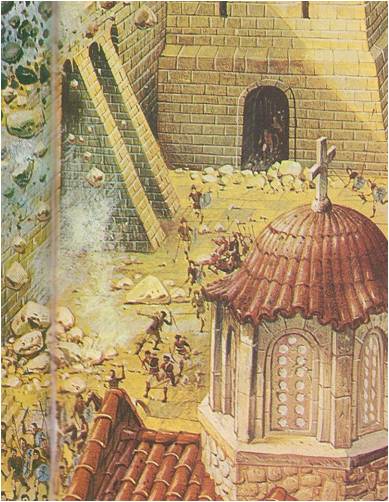ACCORDING to their tradition, the Ottoman Turks once belonged to the same Central Asian tribe as the Seljuk Turks. Their ancestors came to Asia Minor with the Seljuks. In time, they began to challenge the authority of their fellow Turks. The Ottomans took their name from a chieftain called Othman, who in 1299 became the emir of Seljuk lands bordering on the Byzantine Empire. Othman declared holy war on his Christian neighbours. His son Orkhan captured the city of Brusa and in 1362 Orkhan’s son Murad took Adrianople, beyond the strait and sea that separated Asia Minor from Europe. Thereafter, Murad and his son Bayezid pressed forward on two fronts–against Serbs, Bulgars and other Balkan peoples in southeast Europe and against Byzantines and Seljuks in Asia Minor.
By 1400, the Ottomans had conquered Macedonia and Bulgaria, pushed the Byzantines out of Asia Minor and swept the Seljuk emirs from their thrones. In that year, however, Timur attacked the eastern Bank of their kingdom. After devastating Syria, he came back and crushed the Ottoman army near Ankara, taking Sultan Bayezid captive. He restored the Seljuk emirs to their posts. When Bayezid died in 1405, his three sons immediately began to fight over their inheritance. Their struggle raged for ten years. At last Sultan Mohammed came out the winner, with both of his brothers dead.
These civil wars, coming so soon after the Mongol invasion, left the land and the people exhausted. The Ottomans’ fighting spirit soon revived. Under Mohammed and his son Murad II, Turkish armies again advanced across southeast Europe. In 1443, a huge army made up of Rumanians, Hungarians, Poles, Germans and Frenchmen defeated them. Five years later, however, they beat back another massive Christian attack in Serbia.

Murad’s son Mohammed II, became sultan in Adrianople in 1451. He immediately ordered his brother put to death. Having thus rid himself of a potential rival, he turned his attention to the destruction of the Byzantine Empire. This was the main Ottoman goal. For a thousand years the Byzantine capital, Constantinople, had been the eastern center of Christian power. Since the days of the Prophet Mohammed, its soldiers had crossed swords with the armies of the faithful. Although the Byzantines were the oldest enemies of Islam, they were no longer very strong. What was still called an empire was now nothing but Constantinople and the land around it.
For two months, in the spring of 1453, Turkish gunners tried to knock down the walls of the great city with their new weapon, cannon. At last they gave up the attempt and rushed the city gates and on the morning of May 29, they broke through. Shouting the name of Allah and waving their curved swords, they hacked their way from street to street, slaying, among thousands of others, the emperor. About noon, Sultan Mohammed appeared in the city. He ordered the slaughter to stop, and then, entering the magnificent Church of St. Sophia, he formally took possession of Constantinople.
Thus, in just a few hours, the proudest Christian city after Rome became Moslem. As soon as its fortifications were repaired, Mohammed moved there with his court. His kingdom was now an empire, with Constantinople as its centre.
Becoming masters of Asia Minor, the Ottomans pushed eastward to the Persian Gulf, taking Armenia and Iraq. Early in the sixteenth century, they added Persia, Syria, Egypt and western Arabia to their domain. Their greatest triumphs were to come under Suleiman, the son of the Sultan Salim, who had routed the Mamelukes.
Suleiman, who was called the Magnificent, was one of the greatest men in Moslem history. During his long reign, from 1520 to 1566, the Ottoman Empire grew by conquest until it took in more land and people than any Islamic state since the fall of the Omayyads in 750. North Africa as far west as Morocco fell to him. His troops occupied most of Hungary and laid siege to the Austrian capital, Vienna. From Budapest to Baghdad, from the Crimea on the Black Sea to the First Cataract of the Nile in Egypt, his word was law. It was in law, as much as in military affairs, that Suleiman won his fame. He handed down a code of laws which was still being used by Moslem judges three hundred years later.
After Suleiman, the empire went slowly downhill. The Turks assaulted Vienna a second time in 1683, but after that they never again threatened Western Europe. The army became concerned with holding on to Ottoman territory rather than adding to it. In the eighteenth century, France, England and Austria began to cast greedy eyes on the empire’s outlying possessions and in the nineteenth century began to grab them. The fading Ottoman Empire came to be known as the “Sick Man of Europe.” Following World War I, in which it had sided with Germany, the empire was confined to its first home in Asia Minor, plus a tiny area at the southeast corner of Europe. Its capital, Constantinople, was now known by its Turkish name, Istanbul. The empire did not last long. In 1922 it was abolished and the Republic of Turkey established in its place. The Ottomans, the last champions of a united Islam, had disappeared from history.





